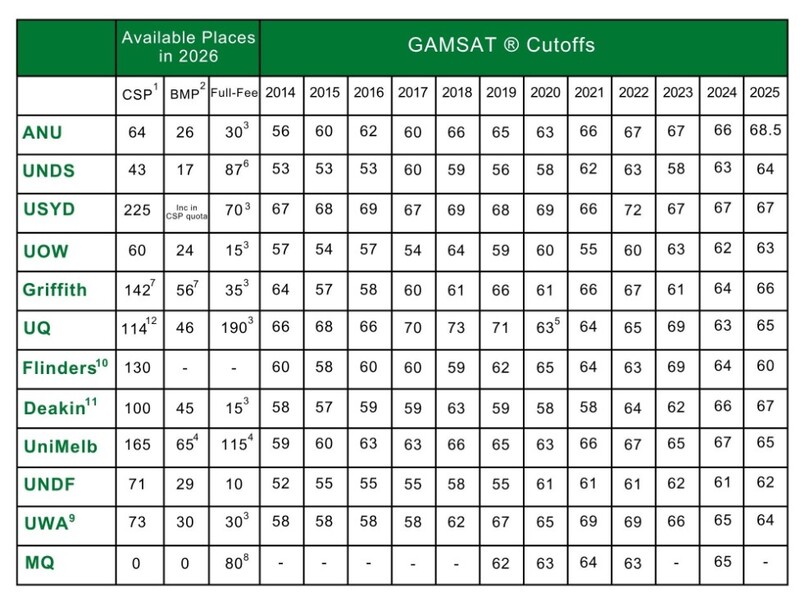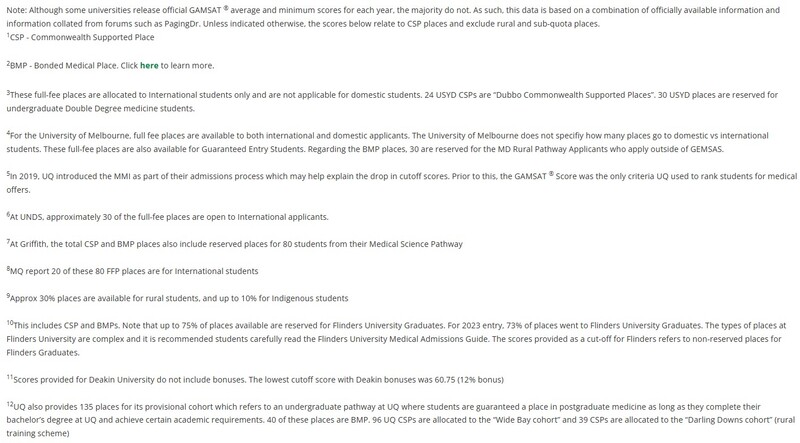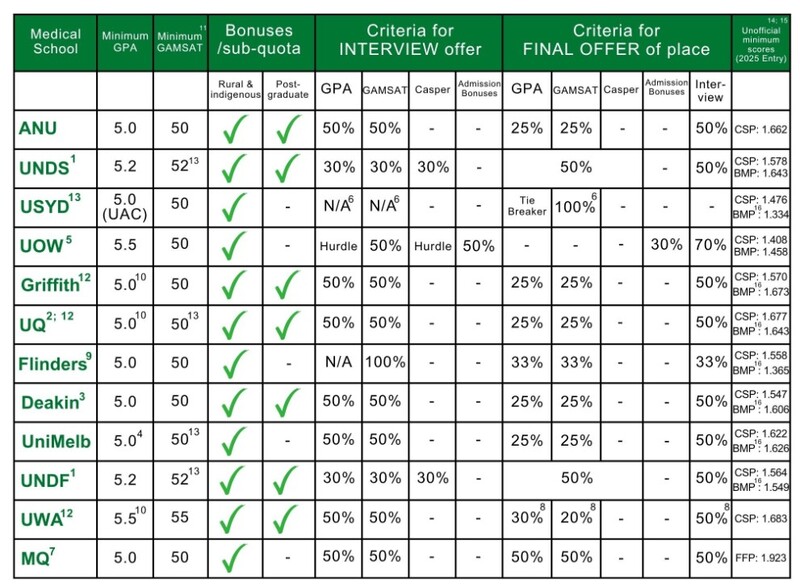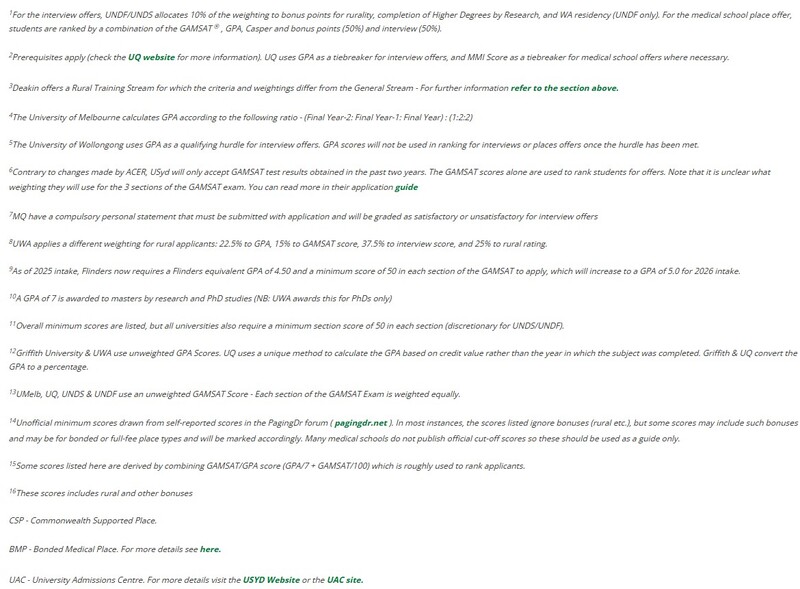We can all exhale now – the first block of anxiety-striking, viscerally painful waiting is done – you have your GAMSAT® score! I’m sure many of you reaped the rewards of small bets with friends about on which date ACER would release the results; I for one know that I owe my best friend a coffee. But as the dust settles and we put the momentary ecstasy of potentially being through with the GAMSAT exam aside, we so often start to be nagged with a far more serious question: is our work here truly done? Is my GAMSAT® score good enough?
Recently, my Facebook feed has been flooded with advertisements presenting various “Entrance Calculators”, based on one’s GPA and GAMSAT®. But it’s just not that simple. Let’s take a closer look at how it all works. There are three types of entrance styles that medical schools like to use to qualify for an interview:
GAMSAT Only Medical Schools
These schools only use your GAMSAT® score to rank applicants for a medical school interview position - note that for the final medical school offer, GPA scores may be taken into account. Generally, other metrics such as GPA are a hurdle – USyd use 5 on a 7-point GPA scale, for example – and you can check all of these in the table below.
‘Cut-offs’ are the minimum GAMSAT® score required to gain entry into a medical school. It’s important to note that this is only a valuable piece of information for GAMSAT®-only medical schools, as the combination score is used for other schools. Below is a table of GAMSAT® cut-offs from previous years using the best open-source information available. The table was taken from our comprehensive guide on
Australian Graduate Medical Schools - Admission Requirements.


It’s important to note that your GAMSAT® Score only makes up one component of your application, and there are various other factors that need to be considered. For more information, you can refer to the section below on the different admissions criteria and weightings. As always, it’s best to get in contact with the relevant medical institutions for further details and up-to-date information.
Here’s where it gets a little bit tricky. These scores are the cut-offs for ‘suburban’ CSP and BMP places, whereas applicants from rural backgrounds can be accepted with lower GAMSAT® and combo scores to incentivise our national requirements for a more rounded, representative medical cohort. In addition, for Flinders University it's important to recognise that the scores above are for non-Flinders Graduates. Flinders University reserves up to 75% of intake for internal Flinders Graduates, meaning that the cutoff scores for the rest of the country are generally a lot higher.
“So if I’m above last year’s cut-off, will I get in?”
Sadly, it’s impossible to say. We cannot predict what this year’s cut-off will be, as can be seen in the table above. Let’s do a thought experiment. Imagine that everyone from Melbourne that sits the GAMSAT® does really well, then proceed to all apply for UniMelb. What’s UniMelb’s cut-off for that year going to be? Astronomical. Additionally, non-GEMSAS schools (USyd, Flinders and Monash) tend to pool applicants who can and want to travel there to interview, so it skews the GEMSAS cut-offs year-to-year, depending on which medical schools are ‘in vogue’. It’s these year-to-year geographical nuances in scores and applications that make it impossible to determine; so best not to even worry about it, just run with what you have got and play to your strengths. If you’re not sure which medical schools to apply to, check out our article Australian Medical Schools - Which One is Best for Me?
GAMSAT & GPA Medical Schools
These schools use a combination of your GAMSAT® and GPA to rank applicants for an interview. Both scores generally contribute 50% to the overall weighting used to rank applicants for an interview, but the exact formula varies across schools and isn't always made available - for example, whether universities use a pure GAMSAT® score alone or the equivalent percentile ranking isn't always clear. Regardless, a combination score can be a useful approximation to help you assess your options and changes. The combination is a certain percentage of an applicant’s GAMSAT and GPA mushed into one concise figure per the following formula:

So in an example of Alex, a student who has a GAMSAT® of 64 and a GPA of 6.57 (on a 7-point scale), the combination score for UniMelb (who take a 50-50 split) is calculated as follows:
6.57/7 + 64/100 = = 0.9386 + 0.6400 = 1.5786
Thus, Alex’s overall combination score is 1.5786
As your GPA is calculated over a smaller scale, a higher GPA will typically be more valuable to your combo score than a higher GAMSAT. Therefore, these schools generally tend to favour those with very high GPAs (> 6.5) and slightly lower GAMSAT® scores. For more information, check out our article: How Does GEMSAS Interpret Your GPA?
Other Notes: Bonuses
Australian medical schools tend to have sub-quotas (sets of places set aside for special applicants) or bonuses for rural, Indigenous and Torres Strait Islander, and previous healthcare applicants. For these individuals, cut-off scores will be slightly lower.
For example, Deakin values previous healthcare experience and thus offers varying levels of bonuses (up to 2% on the combo score) for these applicants. Additionally, they do, given their relatively regional location, value applicants who are from financially straitened backgrounds. Of course, evidence proving eligibility for these criteria are required on your application.
As another example, four schools currently regard previous postgraduate study in the calculation of your GPA score (UQ, Griffith, ANU and UWA). Furthermore, anyone with a PhD or Masters by Research earns a GPA of 7 at Griffith – a pretty good incentive to apply there.
All things considered, your GAMSAT® score probably is good enough; both because you’re an awesome student and because if you consider where you apply with care and wisdom, your GAMSAT® score is not the be-all-end-all. For more information, check out our Guide on GAMSAT Results.
GPA, GAMSAT & Casper Test Medical Schools
It’s also worth noting that as of 2026, the University of Wollongong will only be using the GAMSAT score as a qualifying hurdle for interview offers, but it will not be included in the final offer ranking calculation. Rather, Casper scores and UoW MD admission bonuses will be combined to determine interview offers. Final offers are based on a 70:30 split between interview and MD admission bonuses.
Also note, the University of Notre Dame (Freemantle and Sydney) have a 30:30:30:10 weighting for interview offers as follows:
Therefore, consider looking into these universities as options if you feel your GAMSAT score is on the lower end and you would still like to try your luck at getting an interview.
Australian Graduate Medical Schools - Criteria and Weightings


For those of us that really, really think we don’t have a chance…
If your GAMSAT® or GPA isn’t what you would like it to be - fear not! In truth, it’s not worth the time, money nor effort to apply through GEMSAS or other schools if you ‘know’, based on the information above and below, that you’re going to fall well below the line. Take some time, regroup, gain a better understanding of medical school entry requirements and attack the process again during the next cycle. Likely this means resitting the GAMSAT® – the clearest path to improving your combination score, provided also that your GPA clears the hurdle requirement. But also consider further study such as an Honours year, or a Masters. The reality is that for most of us, this is the way that we get in. But, you know what? The elation, joy and sheer relief of coming out on the upper side of those cut-offs will be well worth the effort; so stick at it.
Some advice on preferences
It is nearly impossible to conceive of a way in which you can ‘play the system’ regarding GEMSAS preferencing. All offers are coordinated centrally via GEMSAS and if a medical school doesn’t want you, you’ll get passed onto your next preference for consideration. Therefore, it is not necessary to be tactical with your preferencing; instead, follow the tips below for the surprisingly simple 6-preference process:
-
Rank all medical schools on a blank piece of paper based on where you would actually want to live/attend/thrive/survive.
-
If you do not want to live somewhere, do not preference it! There is no obligation to fill the six preference slots.
-
If you end up with more than six preferences on that page, cut out the ones for which you would be least competitive.
-
Voilà! Marvel at your list of prospective medical schools.
If you’ve got a great GAMSAT® score, it’s time to prepare for the medical school interview…
Check out our GAMSAT To Med School Podcast for tips & tricks about applying to medical school, the GAMSAT® exam, and life at med school.










